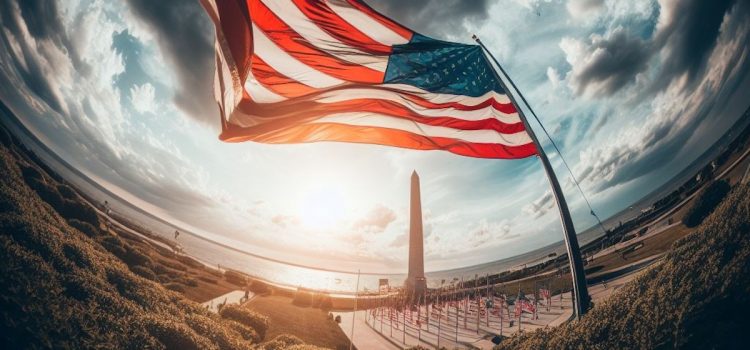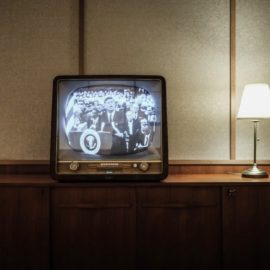
How did control by the elites and a unified political agenda shape America after the 1960s? In what ways were corporations and the security state favored over the disenfranchised?
In A People’s History of the United States, Howard Zinn explores America’s post-’60s political climate. He emphasizes elite control, a unified political agenda, and impacts on domestic and international policies.
Keep reading to get a “people’s” history of modern America, from 1974 to 2001.
Modern America From Howard Zinn’s Perspective
Zinn’s history of modern America focuses on political consensus. He argues that, after the tumultuous ’60s and early ’70s, elites tightened their control over the country. In large part as a consequence of diminished labor power and elite suppression of dissenting social movements, a modern “consensus” emerged in American politics: That is, regardless of party, all American politicians had the same overall political goals.
(Shortform note: While Zinn describes the modern consensus as emerging in the ’70s and persisting beyond the end of the millennium, other historians argue it lasted from the end of WWII with the post-war settlement until around the 1980s. These historians point out that, during this period, Congress was less politically polarized and more likely to make compromises—suggesting they were more amenable to a single consensus regardless of political party. The historians point to the ’80s as the end of this consensus because during this era, members of Congress became more unified around their specific party ideologies.)
Lacking alternatives to this consensus and already distrustful of the government after Vietnam and Watergate, Americans became more disconnected from and disinterested in politics. Zinn briefly outlines the main tenets of the modern consensus:
The Modern Consensus on Domestic Policy
In domestic politics, the modern consensus secured the power of corporations and the security state at the expense of the poor and disenfranchised. Economically, this meant deregulation of corporations, weakening labor power, and dismantling the social safety nets of the New Deal and post-war eras. As a result of these policies, levels of inequality and poverty rose. Desperate and lacking organized ways to express discontent, many poor Americans turned to crime. Elites blamed the country’s problems on these criminals and massively expanded the police and prison systems, issuing harsh penalties for minor crimes.
(Shortform note: While Zinn focuses on how the expanded prison system enforces social control, other experts note that it’s also a source of profit for elites. They describe the prison industrial complex, a network of relationships between the prison system and private businesses that benefit from it. Businesses profit from government contracts to supply or even run prisons. In addition, they benefit from the extremely cheap labor of prisoners, who are paid far less than minimum wage. As the prison system became profitable in this way, it also began to expand—disproportionately at the expense of people of color, who are far more likely to be imprisoned.)
The Modern Consensus on International Policy
Zinn explains that the modern consensus continued the postwar era’s imperial policies—covertly organizing coups, backing dictators, and fighting wars to protect elite business interests. Though America’s “war economy” had ostensibly been for fighting the Cold War, it continued even after the collapse of the Soviet Union in 1991. Not wanting to risk Vietnam War levels of public backlash, American elites tended toward smaller and shorter conflicts that were less disruptive to average citizens.
When the terrorist group Al-Qaeda destroyed the Twin Towers on September 11, 2001, elites capitalized on the event by declaring a “war on terror.” This essentially served as a blank check for military action and the surveillance and security state. With almost all news media pushing pro-war revenge narratives and with anti-Arab racism on the rise, the US invaded Afghanistan weeks after 9/11 on dubious grounds—supposedly, the Afghan government was collaborating with Al-Qaeda.
(Shortform note: Evidence supports Zinn’s claim that the war on terror and the US response to 9/11 was a continuation of US foreign policy instead of a sudden shift in priorities. Specifically, while the US invasion of Iraq in 2003 was pitched partially as an anti-terrorism mission, US elites wanted to invade Iraq years before 9/11. They simply altered existing invasion plans to fit the exceedingly patriotic environment of post-9/11 America. This suggests that 9/11 provided an excuse for an ongoing policy of foreign military intervention.)
| Does the Modern Consensus Still Exist? The final version of A People’s History of the United States was published in 2003. Has the modern consensus Zinn described continued on in the two decades since? Or has US politics shifted into a new era? Let’s go through the elements of the modern consensus Zinn describes and consider which of them still exist today. Domestic policy: On the domestic front, some trends Zinn identified have continued. Union membership has continued to decline since 2003, while wealth and income inequality has continued to increase. The US prison population reached its peak in 2010, but has slowly declined since. However, other trends he discusses are less clear. There have been some small expansions to social safety nets since 2003, including a partial Medicaid expansion in 2010 and a steady rise in federal spending on food stamps. In addition, the poverty rate has remained relatively constant since 2003. Foreign policy: In terms of foreign policy, the trends Zinn discussed seem to have continued. Military spending has remained relatively consistent since 2003. The US has also been involved in numerous invasions: invading Iraq from 2003 to 2011, Libya in 2011, Syria in 2017, and continuing to occupy Afghanistan until 2021. In addition, the US has continued selling large quantities of weapons across the world, including to authoritarian nations like Saudi Arabia and Egypt. And while modern covert coups are difficult to definitively prove, the US has been accused of backing various coup attempts—for example, in Bolivia in 2019 and Venezuela in 2020. |
Popular Resistance
Despite the relative continuity of the modern consensus, Zinn notes several outlets for popular resistance in this era. These often formed to address specific issues, rather than broad movements. For example, large protests against nuclear proliferation, government inaction in the face of the AIDS epidemic, or the South African apartheid government. In addition, popular anti-war protests formed in the wake of various American invasions up to and including the invasion of Afghanistan—where Zinn finishes his history.
(Shortform note: In addition to the individual protest movements, there has also been a small resurgence of leftist and progressive politics in the US since the publication of A People’s History of the United States. Congress members like Bernie Sanders and Rashida Tlaib identify as democratic socialists, while left-wing organizations like the Democratic Socialists of America have grown significantly.)






